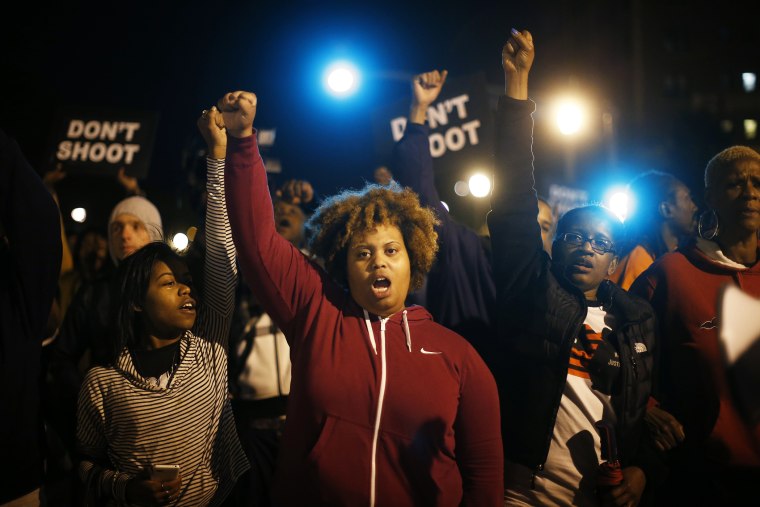FERGUSON, Missouri — For a time, little more than a few inches of space separated a delicate line between peace and chaos.
Protesters tested the limits of the invisible boundary Friday night, toeing dangerously close to the row of officers lined up to protect the police headquarters here. Warnings from law enforcement officials that they may soon begin arresting people were easily drowned out by music and chants from the thickening crowd. Photographers readied their cameras, waiting for something to pop as demonstrators on the front lines stared down their opponents, leaving little room to breathe.
All except for Shermale Humphrey — she was facing the other way.
While the fallout of a teen’s death at the hands of a police officer focused heavily on the day-to-day injustices incurred by young black men, it’s the women who helped turn a string of protests into a movement, by seamlessly shifting between the roles of peace-keepers, disrupters, organizers and leaders.
In Ferguson on Friday night, Humphrey knew exactly what to do when she saw a young man — barely 15-years-old — struggling to contain the energy and anger building up inside him.
Carving space between a police officer dressed in full riot gear and a 6’3’’ tall teen on edge, Humphrey, a tiny young woman with a slight frame easily lost in a crowd, became the physical shield protecting the two sides.
“She’s got an officer in SWAT gear inches from her, and she’s just says, ‘You know what? Ain’t nobody putting their hands on him,’” Thenjiwe McHarris said of her friend on the protests' front-lines, recounting Friday night. “Unafraid too. You gotta see there’s so much power in that.”
Since Aug. 9, when a police officer shot and killed unarmed 18-year-old Michael Brown in broad daylight, women have made up a significant number of the protesters in the streets. Many of the women heard their voices go hoarse after spending hours leading chants and making up rhymes. A number of them have been arrested — even more than once. Others say they’ve spent more time behind bars since Brown’s death than the man who killed him.
“It’s usually men on the forefront, but we gotta step up, we gotta show them that we all are equal,” Humphrey said, “White and blacks gotta be equal as man and woman.”
The protests in Ferguson have given birth to a movement led by groups that are consistently in the trifecta of those marginalized in society — young women of color. In the weeks since the community was roiled by violence and a brutal police crackdown, activist groups like Millennial Activists United emerged on Twitter and the familiar faces on the front-lines of the protests, founded almost entirely by women.
“We’re less concerned with what the police response will be,” said Ashley Yates, one of the founding leaders of MAU. “We want people to come out, we want people to share our resistance.”
One of the most prominent people to take the protests’ message to a national scale by being a barometer of shifting emotions in Ferguson is not only an elected official, but a black woman. Maria Chappelle-Nadal, a Missouri state senator known in part for her controversial and sometimes even profane opinions, rose to national prominence almost overnight due to her response to the protests.
“There are multiple stories of people who are out here and I spent a lot of time with young people. I felt the anger in these young people’s hearts,” Chappelle-Nadal said. “As a legislator, being black, being a woman … we’re pigeonholed, we’re put into a box. I’m sick of it."
For McHarris, women have always been the driving force behind movements. This time, they’re not invisible — people are paying attention.
“Historically, women have always been leading,” McHarris said. “A lot of times women are often unseen leaders because women are all just doing it — we’re all just doing the work.”
